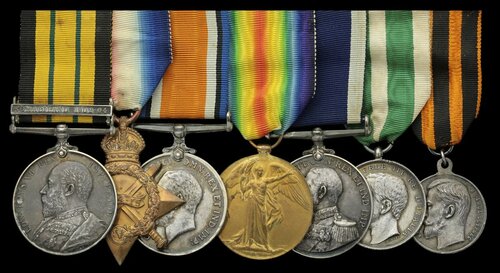
Auction: 21002 - Orders, Decorations and Medals
Lot: 92
The very fine Battle of Jutland Russian Saint George Medal for Bravery campaign group of seven awarded to Chief Petty Officer G. J. Hammond, Royal Navy
Africa General Service 1902-56, 1 clasp, Somaliland 1902-04 (G. J. Hammond, P.O. 2CL., H.M.S. Porpoise.); 1914-15 Star (161137. G. J. Hammond, C.P.O. R.N.); British War and Victory Medals (161137 G. J. Hammond. C.P.O. R.N.); Royal Navy L.S. & G.C., G.V.R. (161137. G. J. Hammond, C.P.O. H.M.S. Monarch.); Italy, Messina Earthquake, 1908, rim privately engraved (G. J. Hammond P.O.1.); Russia, Empire, Order of St. George, Medal for Bravery, 4th Class, silver, reverse impressed, 'No. 1272840', mounted as worn, very fine (7)
George John Hammond was born on 30 April 1875 at Shoreditch, London. A clerk by profession, he joined the Royal Navy and served as Boy 2nd Class at the Portland shore establishment Boscowen from 19 June 1891. Promoted Boy 1st Class on 17 November 1892 and Ordinary Seaman whilst aboard Alexandra on 30 April 1893, he saw further advancement aboard Assistance and Camperdown, being appointed Ships Corporal 1st Class at the 'stone frigate' Excellent on 9 October 1902. On 23 April 1903, Hammond joined Porpoise and took part in the operations on and off the coast of Somaliland against Muhammed bin Abdullah which lasted from 18 January 1902-11 May 1904. The defeat of troops loyal to the Mullah on the Judballi plain by British Commander, General Charles Egerton, forced enemy forces to flee to Majeerteen country on the Horn of Africa, and enabled Porpoise to return home, 237 of the crew qualifying for the clasp Somaliland 1902-04.
Promoted Petty Officer 1st Class on 1 December 1905 at Victory I, Hammond was posted on 25 May 1907 to the battleship Exmouth which at that time served as flagship to the Mediterranean Fleet. It was whilst serving with Exmouth that Hammond is confirmed as assisting with recovery efforts following the earthquake that struck Messina on 28 December 1908. Ultimately this involved digging people out of piles of rubble, the earthquake having devastated the Norman cathedral and trapped almost half the inhabitants of the city in their homes as they slept. The American consulate was reduced to 'a pile of rubble' (Italy's Great Horror, by J. H. Mowbray, refers), and American Consul Arthur S. Cheney and his wife, Laura, were killed. Similar tales were experienced by the French and British consuls: Ethel Ogston, wife of the British Vice-Consul, being killed instantly after being struck by a falling balcony as she attempted to escape through the streets with her family.
Returned home, Hammond was advanced Acting Chief Petty Officer on 1 November 1913 and served aboard the battleship Monarch from 7 April 1914, being aboard her at the outbreak of hostilities and as part of the 2nd Battle Squadron of the Grand Fleet, based at Scapa Flow. Having sailed forth in response to the German bombardment of Scarborough, Hartlepool and Whitby in December 1914, she then sortied in response to an attack by German ships on British light forces near Dogger Bank on 10 February 1916, but was recalled two days later when it became clear that no enemy vessels larger than a destroyer were involved. On the night of 25 March 1916, Monarch and the rest of the fleet sailed from Scapa Flow to support Beatty's battlecruisers and other forces raiding the Zeppelin base at Tondern. By the time that the Grand Fleet approached the area on 26 March, British and German forces had already disengaged and a strong gale threatened the light craft, so the fleet was ordered to return to base. On 21 April, a demonstration was conducted off Horn's Reef to distract the Germans whilst the Imperial Russian Navy re-laid defensive mines in the Baltic Sea. This was repeated from 2-4 May 1916 in an attempt to focus German eyes upon the North Sea and prevent further bombardments of the east coast.
Jutland - Russian reward
On 31 May 1916, Monarch, under the command of Captain George Borrett, was the sixth ship from the head of the battle line after deployment. During the first stage of the engagement, the ship fired three salvoes of armour-piercing capped shells from her main guns at a group of five battleships at 18.32hrs, scoring one hit on the dreadnought S.M.S. Konig that knocked out a 15cm gun, temporarily disabled three boilers and started several fires. At 1914hrs, Monarch engaged the battlecruiser S.M.S. Lutzow at a range of around 18,000 yards with five salvoes of A.P.C. shells and claimed to straddle her with the last two salvoes. Struck similarly by the Orion, the enemy vessel experienced a fair amount of flooding and heavy casualties. This was the last time that Monarch fired her guns during the battle, having expended a total of fifty-three 13.5-inch A.P.C. shells.
Hammond was awarded the Order of St. George Medal for Bravery, 4th Class, as 'conferred by the Russian Government on the following men of the Grand Fleet for services rendered in the Battle of Jutland' (ADM 116/1493, National Archives, refers). However, due to the fact that the Tsar had by then been deposed, the award could not be published in the London Gazette; Hammond would however have received the permission to accept and wear the ribbon of this decoration. He remained aboard Monarch for the duration of the war and was also still serving aboard her when awarded the L.S. & G.C. on 12 January 1919. Demobilised ashore on 20 February 1919, Hammond later enrolled into the Royal Fleet Reserve; sold with copied service record and research.
Subject to 20% VAT on Buyer’s Premium. For more information please view Terms and Conditions for Buyers.
Sold for
£1,700
Starting price
£480




